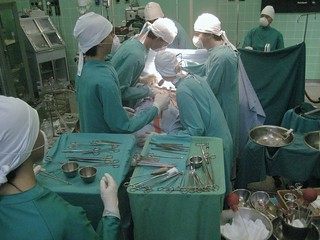By Rick
Fromme
 Many of us know the
iconic painting by Norman Rockwell, where an elderly doctor, with his
ever-present black bag, is checking the pulse of a little girl holding her doll.
Chances are if a similar painting were to be put to canvas today, the elderly
doctor would be replaced by a significantly younger Physician Assistant (PA).
Many of us know the
iconic painting by Norman Rockwell, where an elderly doctor, with his
ever-present black bag, is checking the pulse of a little girl holding her doll.
Chances are if a similar painting were to be put to canvas today, the elderly
doctor would be replaced by a significantly younger Physician Assistant (PA).
If you read my previous blog in February, “HealthCare Job Outlook is Jammin’!” you’ll recall one of
the fastest growing health care fields for the foreseeable future is Physician
Assistant.
There
are several reasons for the rapid growth for this profession. As I’ve stated
before — because it’s driving the function of health care in numerous fields —
we live in a country with an ever-growing elder population. All those
once-young Baby Boomers aren’t so any longer. Secondly, as more medical
students are choosing different specialties other than primary care,
increasingly, PAs are often serving as the frontline primary care providers in
a variety of hospital and clinical settings (along with APRNs). According to
the Bureau of Labor Statistics: “Employment of Physician Assistants is
projected to grow 38 percent from 2012 to 2022, much faster than the average
for all occupations. Increased demand for healthcare services from the growing
and aging population and widespread chronic disease, combined with a shortage
of physicians, will result in increased demand for healthcare providers, such
as Physician Assistants.”
 |
| U.S. Navy Ens. Frank Percy, right, a physician’s assistant from Naval Medical Center San Diego (Photo credit: Wikipedia) |
PAs' responsibilities depend on state laws, practice setting,
their experience, and the scope of practice of the physicians on their health
care team. In general, PAs do physical exams, consult/follow up with
patients, treat various illnesses and injuries, diagnose illness/conditions, do
minor surgical procedures, remove moles and other minor blemishes, drain
fluids, prescribe medications (in all 50 states,
the District of Columbia , and all U.S. territories with the exception of
Puerto Rico), order lab and diagnostic tests, admit patients to
hospitals, provide patient education and counseling,
make rounds in hospitals and nursing homes, and
even evaluate patients’ oral health … and more. For example, PAs working in a
cosmetic surgeon’s office may do laser procedures on a patient’s skin or remove
sutures after a facelift. As you can
see, PAs’ tasks and responsibilities are highly varied; hardly ever a dull day
in this demanding profession. “It’s the closest thing to being a doctor without
actually becoming one,” a PA friend of mine quips. he’s not far from the truth.
Some of the
specialties employing PAs:
Family Practice/Primary Care/General Medicine
Internal Medicine
Internal Medicine Subspecialties
OB/GYN
Orthopedics
Pediatrics
Emergency Medicine
General Surgery
Surgery Subspecialties
PA Educator
Regardless
of the specialty, PAs are highly trained to deliver
excellent medical care. In fact, research shows patients are just as satisfied
with PA-provided care as they are with physician-provided care. PAs work
in urgent care, primary care, industrial medicine and even surgery. About 60%
of PAs work in primary care specialties such as general and family medicine.
The remainder work in sub-specialties such as surgery
and orthopedics. Pick a
medical specialty; these days, you’ll often find a PA or two serving along side
or
under the supervision of an M.D. PAs that
practice in hospitals work in almost all patient-focused departments and
practice with physicians in every medical and surgical specialty. PAs may be
employed by the hospital (or system), medical practices or hospital medicine
groups.
 |
| Heart of Cape Town Museum (Photo credit: mallix) |
Most
PAs see between 20 to 30 patients a day; depending upon their work environment
and number of other staff members available to treat patients. For example, a
PA that’s the primary care giver at a retail walk-in clinic (publically or
privately owned) may see more patients than a PA who works at one of several regional
care centers that belong to a major hospital. That’s because the
hospital/corporate owned facility may have a few doctors, APRNs and perhaps a
few other PA s on-site that help manage the work load. As well, these
facilities usually have a larger support staff, which can help diminish PAs requisite
paperwork (charts, prescription refills, insurance documentation, lab results, etc.).
PA s working in hospitals and major medical centers may carry more shifts
throughout the evenings and weekends.
Education
 |
| OUCeremony-039 (Photo credit: The Open University (OU)) |
Like
many of the top health care jobs, to become a PA-C (Certified Physician
Assistant), one must obtain a Master’s degree from an accredited program and
then pass a state licensure exam. Similar to
medical school, PA’s education includes instruction in core sciences: anatomy,
physiology, biochemistry, pharmacology, physical diagnosis, pathophysiology,
microbiology, clinical laboratory science, behavioral science and medical
ethics. Also similar to a doctor’s medical school curriculum, PAs undergo a combination of classroom and clinical instruction. The average length of a PA’s
Master’s degree takes about 26 months. It’s described as being “rigorous and
intense.” Graduates of accredited PA programs are
eligible to take the Physician Assistant National Certifying Exam (PANCE)
administered by the National Commission on Certification of Physician
Assistants. Some
PAs further their education to the doctorate level education in a specialty of
their choice (usually after several years of hands-on clinical care practice).
There has been talk of advancing the requisite PA degree requirement to
doctorate level, not unlike a DNP (Doctorate Nurse Practitioner) but nothing
official has been established yet.
In this article I talked about Physician
Assistants. I cited reasons for the profession’s increased growth rate, gave an
overview of PAs numerous job functions/responsibilities, cited various
specialties employing PAs and facilities where PAs practice, and discussed the
educational and licensure requisites for becoming a PA-C (Certified Physician
Assistant).If you
found this article useful and informative, please leave a comment below. Also,
feel free to share it with your colleagues and friends.
Rick Fromme combines
entrepreneurial enthusiasm with an insider's knowledge of the medical industry
to co-found MedMasters.com. Both
his drive and perspective helps provide health care professionals with a
superior mechanism with which to communicate, network and market their
strengths. Prior to founding MedMasters.com, Rick
operated a highly successful medical device distributorship. Other milestones
in his 12-year career in the medical industry include a key position at a
medical device start-up company that was later sold to the Ethicon
Endo division of Johnson & Johnson. You may also reach Rick
by connecting with him on Facebook, Twitter, Google+, LinkedIn and YouTube.












Physician's Assistants are one of the most important facets of the medical profession today. When most of us go to the doctor, we spend more time with the PA than with the doc.
ReplyDeleteYou have to admire anyone who goes through this much training for a career. Its my hope that PA's will help lower the cost of doc visits! :D
ReplyDeletePAs and Nurse Practitioners will be the main pros we'll be seeing in primary clinics, I predict.
ReplyDelete